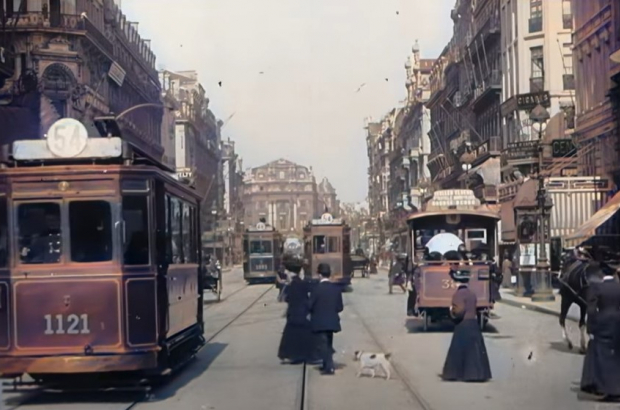- Daily & Weekly newsletters
- Buy & download The Bulletin
- Comment on our articles
Colourised film of Brussels in 1908 shows city in all its splendour
A newly colourised and digitised film of Brussels from 1908 provides an enhanced glimpse into a time when horses, carriages and electric trams dominated the streets of the Belgian capital, a city which now swarms with cars and other vehicles.
The video, created by a Dutch YouTube channel which specialises in the digital restoration and colourisation of archival footage, shows Brussels in the final year of King Leopold II’s reign and takes in many of the city’s landmarks such as the Stock Exchange, the Justice Palace, Parc du Cinquantenaire, the town hall on the Grand Place, and the Royal Palace, among many others.
The eight-minute-long film, the original of which was released into the public domain by the Prelinger Archive, ends with a tram ride through the Sonian Forest on the outskirts of Brussels and a view of what is now known as the Royal Museum for Central Africa in Tervuren, which was built to showcase King Leopold II's Congo Free State in the International Exposition of 1897.
The original black-and-white video, of a very degraded quality, had already been posted in 2013 on the YouTube account of Cinematek, which attributes it to a British production company.
Using a motion stabilisation technique and tools to correct speed, contrast, brightness, sharpness, and remove dust and stains, the now high-definition film provides viewers with a stunning snapshot of another world.
Brussels in 1908, much like today, is a city bustling with life – but the differences are striking. We see carriages, horse-drawn carts, trams and bicycles flowing through Boulevard Anspach, dominated by the old Continental Hotel in its pre-Coca Cola sign era.
Pedestrians – both adults and children – stroll through the Schuman neighbourhood, long before the EU institutions and buildings took over the area; the ladies and gentlemen walking the streets are elegantly dressed; the men in suits and top hats, the ladies in feathered hats and long dresses. It is the Belle époque, the time of Art Nouveau and of Belgium flourishing under the reign of Leopold II.
While areas such as Schuman and Place Rogier are unrecognisable to those we know today, other landmarks such as the Stock Exchange and the Grand Place have changed little in over a century.
The closing sequence shows a panorama of Brussels, from west to east, apparently captured from the heights of Albert Avenue in Forest. In the distance, we see the Porte de Hal, the Palace of Justice, the Church of Our Lady of the Chapel in the Marolles, and the town hall of Saint-Gilles.




















Comments
I bet the people of Brussels back then were complaining about those trams racing through the middle of the streets, the poor migrants speaking a foreign tongue, and, mostly, the city's decision to fell a few trees.